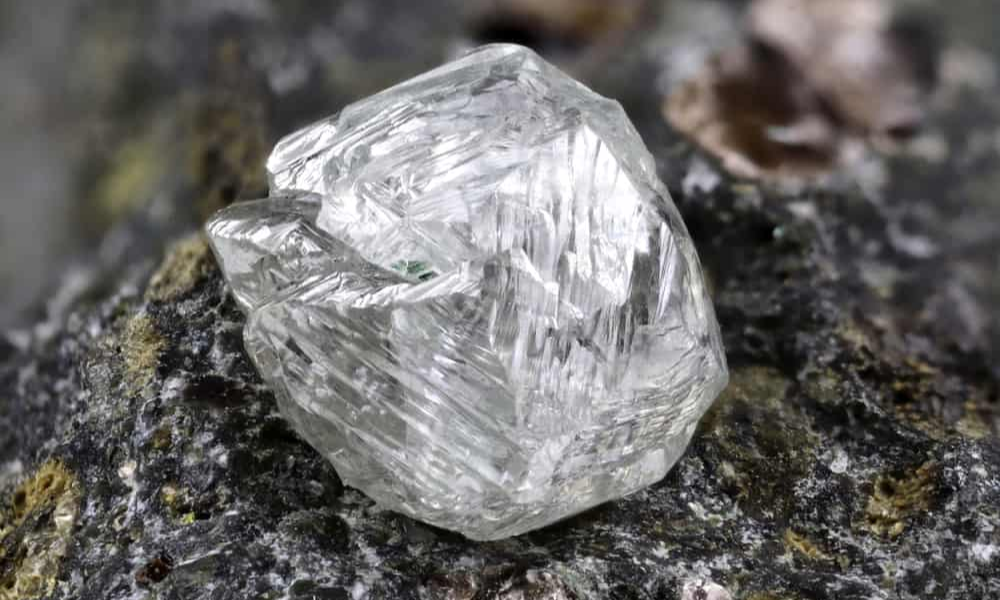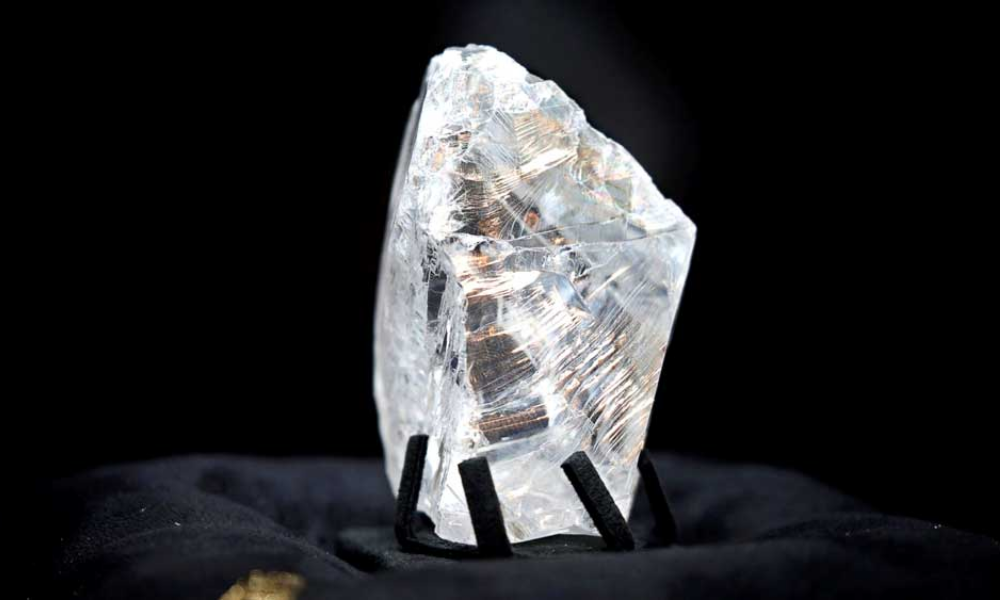If you are interested in learning how to identify a rough diamond, you have probably noticed that there are several different shapes that it comes in. However, you don’t need a microscope to determine whether or not the stone is a diamond. Instead, you can use the characteristics of a diamond to determine its worth. If you’re not sure, you can always visit a lab that specializes in diamonds.
To determine whether a diamond is rough, look for a thin layer of vaseline on the surface. Identifying a diamond’s cut can be tricky, but it’s not impossible. Most diamonds have some type of inclusion, and these are often visible to the naked eye. They can range from cracks running through the stone to hollow areas, or even actual crystals of another substance. Some types of inclusions are diopside, spinel, or garnet. Even if they’re visible, diamonds are still valued for their inherent beauty.

What Is A Diamond That Isn’t Cut?
The uncut varieties of fine diamonds are known as raw diamonds or rough diamonds. These stones take a long time to develop and remain undisturbed before mining companies arrive to mine them. However, it is only due to volcanic eruptions that they become available to us humans.
It’s unsurprising that the industries reduce cut diamonds to a fraction of their original size. The volcanoes’ intense heat and pressure cause the carbon atoms to bind together and form a structure. They will form rough diamond-like crystals after cooling.
Raw diamonds, in most cases, resemble a pair of pale-colored glasses. Because these stones haven’t been cut yet, don’t expect them to gleam with their greasy appearance. Rough diamonds also have a high gem quality, with only the palest and colorless passing the test.
Tips To Recognize A Raw Diamond
It’s difficult to come upon a rough diamond when out strolling. They appear to be scarce and are mostly found in mining sites, but that doesn’t imply you won’t run across one. It’s not easy to tell the difference between raw diamonds and processed diamonds, but here are some things to look for.
1. Concentrate on Gravity
If you’re hunting for a rough diamond, you should be aware of its specific gravity. The density of a diamond varies between 3.5 and 3.53 g/ml, which is the ratio of the stone’s density to a pure liquid with a thickness of 1 g/ml. However, this gem’s identification should not be confused with quartz with a gravity of 2.6 to 2.7.
It’s simple to distinguish the raw diamond from other diamonds thanks to gravity. You may also use shaker tables to separate diamonds from other gemstones utilizing this feature. The following is a step-by-step guide to using this tool:
Fill a transparent, standard-sized drinking glass to 3/4 capacity with water.
Then, in the glass, drop the stone you have.
The stone is a real raw diamond if it sinks. If it floats, though, it’s a fake.
2. Perform a Thermal Absorption Test
Diamonds are the best heat absorbers of all gemstones. Diamond testers can be used to validate this on your stone. These hand-held instruments have a metalhead that makes contact with the diamond under test.
Have you ever been curious about how it works? It generates a modest quantity of heat and monitors how quickly the stone absorbs it. If your stone is a raw diamond or just another lovely stone, a professional tester will be able to identify the difference.
A diamond tester can be found in any reputable jewelry store. As a result, you don’t need to purchase this item to determine whether or not your stone is a genuine diamond.
3. Perform a Toughness Test
Every diamond, whether rough or refined, is without a doubt the toughest of all jewels. On the Mohs scale of hardness, which ranks minerals from softest to hardest, this diamond receives the highest rating. But how can you determine the hardness of a stone if you have one?
So, don’t use the suspected stone to scratch glass. Glass has a Mohs hardness of 5.5, which means that most stones that resemble diamonds may scratch it. Furthermore, because they are more frequent than diamonds, the test will be unreliable.
Scratch corundum to achieve nice results. Surprisingly, the stone has a Mohs scale value of 9 and contains rubies and sapphires. If your stone scrapes corundum, it’s almost certainly a diamond.
Scratch-resistant metals such as cubic zirconia and moissanite, on the other hand, are available. As a result, other tests, such as the heat test, are more dependable than the hardness test.
4. Perform a UV (ultraviolet) Light Test
When inspecting your stone for authenticity, keep in mind that 30% of diamonds fluoresce blue when exposed to shortwave UV radiation. It will occur once you place a diamond under ultraviolet light. However, some will shine and generate different colors, such as yellow, red, or orange, making this procedure ineffective.
For the most accurate results, utilize the tester tool with all of these tests. Other methods can also be used to determine whether or not your stone is a raw diamond. Here are a few examples:
To see if the stone will break, heat it up. If it doesn’t, there’s a good chance it’s a rough diamond.
Make use of a fog test.
Look for the diamond’s crystal shape.
Raw Diamonds have a Variety of Applications
Rough diamonds, like refined diamonds, are indispensable. These gems retain some of their greatest properties before being cut. The most common applications for raw diamonds are listed below.
Jewelry-Making
Raw diamonds are used by a lot of people in the jewelry industry. These traders have been using these diamonds as a token of love for a long time. Aside from that, some merchants sell rough diamonds as decorations rather than cut diamonds.
Applied to Industry
These diamonds are used by businesses for a variety of industrial purposes. The majority of people refer to them as “industrial diamonds.” Despite the fact that some people merely utilize them to make jewelry, raw diamonds end up doing difficult tasks.
To boost performance, companies include raw diamond pieces into cutting blades. Others cut grooves in the concrete with diamond saws.
When it comes to drilling for oil, these corporations rely on raw diamonds. Diamond grains are embedded in the metal caps to aid in the process.
Rough diamonds also make excellent polishing tools. These businesses turn diamonds into a paste that may be used to polish various products.
What is the Difference Between Different Types of Raw Diamonds?
There are three sorts of raw diamonds found all over the world. Most folks proceed to cut them and obtain refined ones from this point. Here’s a quick rundown of the many types:
Natural Raw Diamonds
These are the diamonds that are extracted from the earth by mining companies. The stones, on the other hand, are costly due to the numerous processes needed in obtaining them from their sources. Companies have been mining these stones in their natural state all along, but below are the world’s most famous rough diamonds.
- Sergio rough diamond: It is the world’s largest rough diamond. It is 3,167 carats in weight. Unfortunately, it can only be used for industrial purposes and not for jewelry making.
- The Cullinan diamond is one of the world’s most valuable raw gemstones. It has a weight of 3,106.75 carats and can be used in both industrial and jewelry applications. It also gave birth to Africa’s finest star, with a weight of 530.4 carats.
- Tiffany Yellow diamond: This raw diamond, weighing 287.4 carats, is one of the largest yellow diamonds ever discovered. It can be used in both the jewelry and industrial sectors.
- The Taylor-Burton Diamond is a popular choice among many individuals, despite the fact that it is not the largest. It weighed 241 carats at first, before being trimmed.
- Salt and raw pepper diamonds: Don’t be shocked if you see these jewels as rough diamonds. They differ in that they come in a variety of colors, including non-clear and grey. Raw salt and pepper diamonds are used to make rose-cut diamonds. They do, however, lack a substantial surface area, which may lead you to doubt their authenticity as genuine diamonds.
Remember that you may come across other natural raw diamonds in addition to those mentioned.
Raw Diamonds from a Lab
These are uncut diamonds obtained by laboratory techniques, thus there are no mining costs involved. They aren’t phony rough diamonds because they have the same characteristics as actual diamonds dug from the ground. Surprisingly, possessing these jewels has more benefits than having natural ones.
Lab-grown diamonds are inexpensive, environmentally friendly, and ethically sound.
How do you Tell Whether a Diamond is Rough at Home?
Examine the diamond with a loupe or a microscope for rounded edges with tiny indentation triangles. Parallelograms or rotated squares will be found in cubic diamonds, on the other hand. A genuine raw diamond should also appear to be coated in vaseline. Diamonds that have been cut will have sharp edges.
Another easy way to determine whether a rough diamond is a diamond is to look at its sparkle. While the sparkle of diamonds is undoubtedly a hallmark of the perfect gemstone, a raw diamond lacks the spark and is almost transparent. If this is the case, a flawless raw diamond is worth more than a cut diamond with a low clarity grade. The more color in a diamond, the less lustrous it is.
You can also check for the presence of cracks and cleavage lines. These features are caused by radiation from the rock that’s near the diamond. They can be small spots or completely covered. They usually look like a normal stone or quartz, but they do have a few differences. While these differences don’t necessarily make the stone less valuable, you should still take note of its rarity. Before you buy a diamond, make sure you understand how much it’s worth and what the rough diamond is worth.
What is the Best Way to Know if a Stone is a Diamond?
Place the flat side of the stone on the dot. Look down on the paper through the diamond’s pointed end. If the gemstone has a circular reflection inside it, it is a fake. If there is no dot or reflection in the stone, the diamond is genuine.
A diamond can be anywhere from 8mm in length to two grams in weight. This means that it’s rarer than you might think, and chances are that you’ll find one in a billion or 10,000000 times. You can test a diamond’s cut with a tester, so you can be sure that it’s a real diamond. However, it’s still important to get a professional diamond examination to confirm its authenticity.
Conclusion
If you are unsure of its authenticity, you can use an ice cube as a test. This test works well on most types of diamonds and allows you to see the stone’s characteristics before purchasing it. You should also use a magnifying glass to check for any inclusions. While a fake diamond is perfectly formed, a real diamond will have inclusions and imperfections. You can also check its crystal form, which will help you differentiate it from other minerals.
In addition to its color, you can also check the shape and density of a rough diamond. A rough diamond should have a transparent appearance and feel a little tacky. The surface should feel like a thin film. In addition, you can also tell if a diamond is a real diamond if you scratch a glass. Many materials scratch glass, so don’t be fooled by the glossy surface of fake diamonds.







